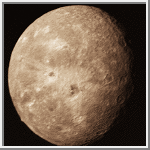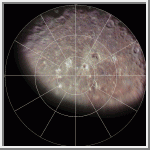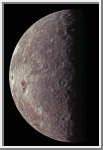 Oberon
Oberon
Uranus IV
Oberon [O-buh-ron] is a moon of Uranus that is characterized by an old,
heavily cratered, and icy surface. The surface shows little evidence of
internal activity other than some unknown dark material that apparently
covers the floors of many craters. The above image shows several large
impact craters towards the center of the image. On the
limb, a high mountain rises 6 kilometers
(4 miles) above its surroundings. There are bright rays similar to
those seen on Jupiter's moon
Callisto.
| Oberon Statistics
|
|---|
|
|
|---|
| Discovered by | William Herschel
|
|---|
| Date of discovery | 1787
|
|---|
|
|
|---|
| Mass (kg) | 3.03e+21
|
|---|
| Mass (Earth = 1) | 5.0703e-04
|
|---|
| Equatorial radius (km) | 761.4
|
|---|
| Equatorial radius (Earth = 1) | 1.1938e-01
|
|---|
| Mean density (gm/cm^3) | 1.64
|
|---|
|
|
|---|
| Mean distance from Uranus (km) | 582,600
|
|---|
| Rotational period (days) | 13.46324
|
|---|
| Orbital period (days) | 13.46324
|
|---|
| Mean orbital velocity (km/sec) | 3.15
|
|---|
|
|
|---|
| Orbital eccentricity | 0.0008
|
|---|
| Orbital inclination (degrees) | 0.10
|
|---|
|
|
|---|
| Escape velocity (km/sec) | 0.729
|
|---|
|
|
|---|
| Visual geometric albedo | 0.24
|
|---|
| Magnitude (Vo) | 13.94
|
|---|
 Oberon
Oberon
This image of Oberon shows several large impact craters towards the
center of the picture. Many of the crater floors are covered by an
unknown dark material. On the bottom-left limb,
a high mountain rises 6 kilometers (4 miles) above its surroundings.
Bright rays similar to those seen on Jupiter's
moon Callisto, can be found on Oberon's surface.
(Credit Calvin J. Hamilton)
 Polar Stereographic Map of Oberon
Polar Stereographic Map of Oberon
This image is a polar stereographic Map of Oberon. The 0° longitude
is at the top in the map.
(Courtesy A.Tayfun Oner)
 Color Image of Oberon
Color Image of Oberon
This image is a reprojected view of Oberon using the above map.
(Courtesy A.Tayfun Oner)

 Uranus
Uranus
 Titania
Titania

Copyright © 1997 by Calvin J. Hamilton.
All rights reserved.
 Oberon
Oberon
 Polar Stereographic Map of Oberon
Polar Stereographic Map of Oberon
 Color Image of Oberon
Color Image of Oberon

 Uranus
Uranus Titania
Titania